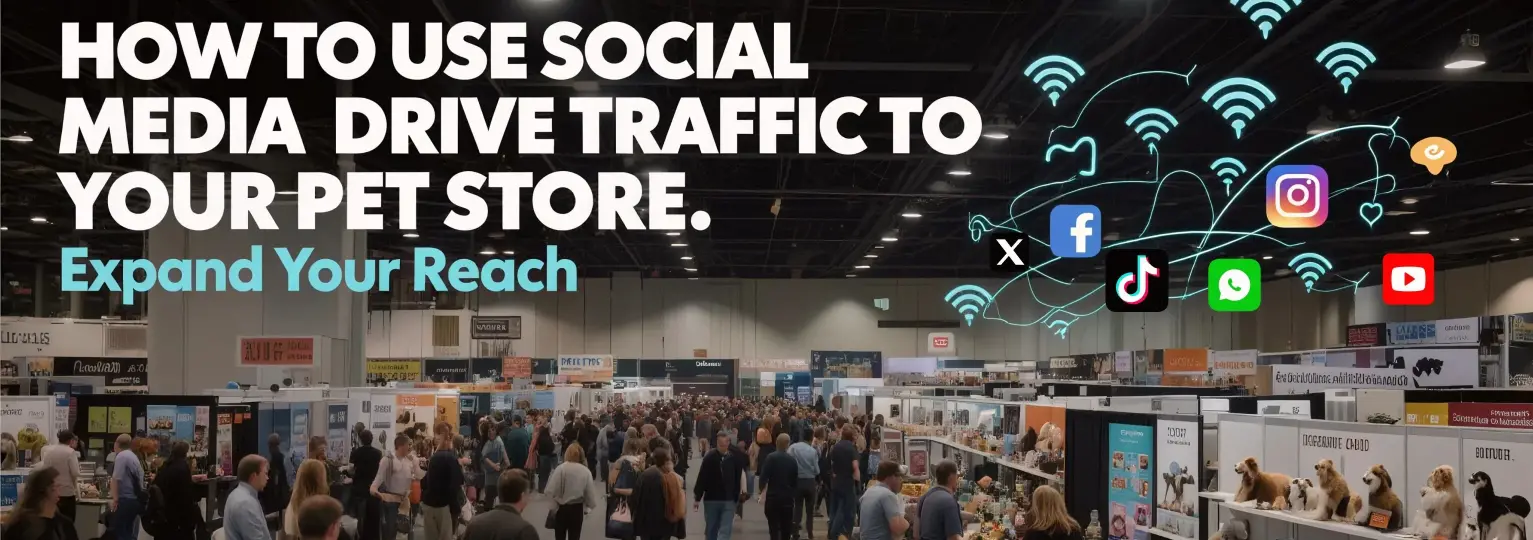How to Use Social Media to Drive Traffic to Your Pet Store

In today’s digital world, social media isn’t just a place to share cute cat videos or dog memes. For pet store owners, it’s become a powerful tool to attract new customers, build brand loyalty, and drive both online and foot traffic. But how exactly can you harness the full potential of social media to boost your pet store’s visibility and sales? Let’s dive into actionable strategies that will not only engage your audience but also help convert them into loyal customers.
Why Social Media Matters for Pet Stores
The rise of social media has revolutionized the way businesses interact with customers. For small businesses, particularly pet stores, it offers a unique opportunity to showcase products in an engaging, visually appealing way. According to recent data, 70% of pet owners follow pet-related brands on social media, and 50% of pet owners say social media influences their purchasing decisions. In other words, your pet store’s social media presence can significantly impact your sales—whether you’re running an e-commerce site, a physical store, or both.
But it’s not just about visibility. Social media also allows pet stores to create a connection with their audience. It’s a place where you can highlight your products, share valuable content, and engage with pet owners, building trust and turning first-time visitors into repeat customers. Whether you’re trying to drive foot traffic to your store or increase online sales, social media marketing is essential to your store’s growth.
1. Understanding Your Audience
Before you even start posting, it’s crucial to understand your audience. Who are your customers? What do they care about? Are they new pet owners? Longtime pet parents? Pet product enthusiasts? Answering these questions will guide the type of content you create and how you engage with your followers.
- Identifying Pet Owner Demographics Pet owners span a wide range of ages and lifestyles. Some are young adults looking for fun, trendy products for their pets, while others are more seasoned pet parents searching for premium pet care solutions. Understanding these demographics helps you tailor your posts to what will resonate most with them. Are you targeting dog owners in urban areas? Or perhaps cat lovers who are passionate about holistic pet care?
- Tailoring Your Content to Their Emotions Pet owners are deeply connected to their pets, and that bond is a goldmine for content creation. Instead of focusing on the hard sell, try to appeal to their emotions. Share heartwarming stories about pets, rescue initiatives, or funny moments that make them smile. For example, creating a series called “#PetMoments” where customers share their pets’ cutest or most mischievous moments could foster a deeper connection.
- Engagement Over Promotion The key to growing a loyal social following is engagement, not promotion. Ask questions, share polls, and encourage followers to interact with your content. This creates an ongoing conversation, making your followers feel heard and valued rather than just being sold to.
2. Choosing the Right Social Platforms for Your Pet Store

With so many social media platforms available, it’s important to focus your efforts where your audience spends the most time. Here’s a breakdown of how each platform can benefit your pet store:
- Instagram: Visual Storytelling Instagram is the platform for all things visual—and when it comes to pets, visuals are everything. The best way to use Instagram is by showcasing your products in real-life situations. Post pictures of dogs enjoying your toys, cats lounging in cozy beds, or a cute dog wearing your pet apparel. Additionally, leveraging user-generated content (UGC) is key. Encourage customers to share photos of their pets with your products and repost them. This not only builds trust but also helps spread the word organically.
- Facebook: Building a Community Facebook is ideal for creating a more engaged community. Start a Facebook Group for pet owners where they can share tips, post photos, and discuss their pets’ needs. You can also use Facebook for event promotion, like sales or in-store events, and Facebook Ads are a great way to target specific groups based on interests and behaviors. If you sell specific products for dogs or cats, Facebook’s ad targeting allows you to hone in on these pet owners specifically.
- TikTok: Fun, Viral Content TikTok is all about viral content. Pet-related videos on TikTok often go viral because pets doing funny or adorable things naturally capture the audience’s attention. Use this to your advantage by creating content that showcases your products in fun, creative ways—whether it’s a dog unboxing a new toy or a pet challenge that includes your store’s products. TikTok’s algorithm makes it easy for small businesses to gain visibility, so even a small following can help boost your store’s presence.
- Pinterest: Inspiration and Discovery Pinterest is a great platform for discovering new products and ideas, especially in the pet niche. Create boards that showcase your products in action, from dog beds and cat trees to pet-themed home décor. You can also create boards with pet care tips and product recommendations, driving traffic to your website when users click on your pins.
- YouTube: Informative Content YouTube’s long-form video content is perfect for product demos, tutorials, and reviews. Create videos on pet care, training tips, or the benefits of specific products. How-to videos, like "How to Groom Your Dog at Home," or "Best Pet Products for New Dog Owners" are excellent ways to add value to your audience while showcasing your products in action.
3. Content Strategies to Engage Pet Owners
Creating high-quality content that resonates with pet owners is the key to driving engagement. Here are some content strategies to keep your audience coming back for more:
- High-Quality Visuals Pet owners love to see their furry friends enjoying new toys, clothes, or treats. Focus on creating high-quality, visually appealing content. Whether it's a beautifully shot image of a dog playing with a new toy or a video of a cat lounging in a comfy bed, these visuals will capture your audience’s attention and encourage them to share.
- User-Generated Content Nothing builds trust faster than seeing real people (or pets!) enjoying your products. Ask your customers to share photos or videos of their pets with your products and repost them. Not only does this show potential customers that your products are loved by others, but it also helps you build a sense of community.
- Educational Content Provide valuable content that educates your audience on pet care, training, and other relevant topics. You could post tips for grooming, training, or maintaining a healthy pet diet. This type of content helps establish you as a trusted resource and keeps your audience engaged long term.
- Seasonal Content Aligning your content with holidays and special events is a great way to stay relevant. Whether it's Christmas-themed pet products, pet costume ideas for Halloween, or tips for keeping pets cool during summer, seasonal content helps drive engagement and sales, especially when people are in the mood to spoil their pets.
4. Running Contests and Giveaways to Boost Engagement
Contests and giveaways are fantastic ways to engage your audience and increase your followers. Here’s how to design a pet-centric giveaway that works:
- Designing a Fun Giveaway Make it easy and fun for followers to participate. Run a “Cutest Pet Costume” contest or a “Best Pet Trick” challenge and offer a prize from your pet store. Not only will this drive engagement, but it will also spread awareness of your brand as people share their entries.
- Partnering with Influencers Partnering with influencers can help you reach a wider audience. Collaborate with pet influencers for giveaways, where both you and the influencer promote the event. This not only boosts your reach but also builds trust as their followers will see you as a brand they can trust.
5. Utilizing Paid Ads to Target Pet Lovers

If you want to boost your reach even further, paid ads can be an excellent way to target specific audiences. Here’s how:
- Facebook & Instagram Ads Use paid ads to promote your top-selling products, seasonal promotions, or any special sales. Facebook and Instagram offer advanced targeting tools, allowing you to reach dog owners, cat lovers, or even pet parents in your specific geographic area.
- Targeting Specific Audiences Paid ads allow you to reach specific pet lovers based on interests, behaviors, and demographics. You can target users who are interested in dog training, exotic pets, or even holistic pet care, ensuring that your ads are shown to those most likely to purchase your products.
6. Collaborating with Pet Influencers
Influencers have become a powerful marketing tool for pet stores looking to increase their reach and credibility. Pet influencers have loyal, engaged followings, and their endorsement can do wonders for your brand’s visibility and trustworthiness. Here’s how you can effectively collaborate with influencers:
- Why Pet Influencers Matter Pet influencers are people who have established a strong relationship with their audience, often based on shared love and care for animals. Their followers trust their opinions, and when they promote a product, it’s not just an ad—it’s a recommendation. Influencer marketing can be a key way to amplify your brand’s message and create a buzz around your products.
- Types of Influencer Partnerships You can partner with influencers in a variety of ways: Sponsored Posts: The influencer posts a photo or video using your products, usually in exchange for payment. Product Reviews: Send your product to influencers for free in exchange for an honest review. This provides authenticity and builds trust. Unboxing Videos: Pet influencers often love to share their unboxing experiences with their followers, making it a great way to highlight your products in a natural, fun way. Affiliate Marketing: Work with influencers to create affiliate links, so they can earn commissions for sales they generate. This is mutually beneficial and incentivizes influencers to promote your products.
- Finding the Right Influencer Not all influencers are created equal. It’s essential to partner with the right influencers who align with your brand’s values and audience. You don’t necessarily need to go for someone with millions of followers. In fact, micro-influencers (those with 10k-100k followers) can often provide a higher engagement rate and more targeted reach. Look for influencers whose audience consists of pet owners or people with similar interests to your products.
7. Tracking Success: Analytics and Metrics to Monitor
To determine the effectiveness of your social media strategy, you need to track key metrics. This helps you understand what's working, what’s not, and how to adjust your approach to optimize performance. Here are some essential metrics to keep an eye on:
- Engagement Rates Engagement (likes, comments, shares, and interactions) is one of the best ways to measure how well your content is resonating with your audience. The more engagement your posts get, the more likely they are to be seen by a larger audience, thanks to social media algorithms. Example: "Look at the average engagement rate per post. If a post about a new product is getting lots of shares and comments, it’s an indicator that your audience is interested in what you have to offer."
- Traffic Analytics Track how much traffic your social media posts are driving to your website. By using UTM links or link tracking tools, you can see exactly how many people clicked on links in your posts, went to your website, and browsed your products. Example: "If you’re running a special promotion on Instagram, track how many users click through to your site to take advantage of the offer. You can use Google Analytics or Facebook Insights to track traffic from social media platforms."
- Sales Conversions Ultimately, your goal is to turn social media followers into paying customers. Use conversion tracking to determine if your social media activities are generating sales. Set up e-commerce tracking on your website to see which posts or ads result in purchases. Example: "For a specific product launch, track which social media posts led to the most sales. If you’re using Instagram Stories with a link to a product page, this will show you how many purchases came directly from the Story."
- Tools to Help Several tools can make tracking and analyzing your social media efforts easier. Use Facebook Insights, Instagram Analytics, and Google Analytics to monitor engagement and traffic. Additionally, social media management tools like Hootsuite, Buffer, and Sprout Social offer detailed analytics that help you keep track of all your accounts in one place.
8. Consistency and Timing: When and How Often to Post
Consistency is key when it comes to social media. But it’s not just about posting regularly—it’s also about posting at the right times to reach the highest number of engaged users. Here’s how you can make the most of your social media efforts:
- Frequency of Posts Posting consistently helps keep your brand top of mind. But how often should you post? There’s no one-size-fits-all answer, but posting 3-5 times a week on platforms like Instagram and Facebook is a good starting point. Avoid posting too often, as it could overwhelm your audience. Conversely, posting too infrequently might cause you to lose visibility. Example: "Try posting 3-4 times a week on Instagram. Spread out your posts across the week so you're consistently engaging with your followers."
- Best Times to Post Timing is everything. To ensure your posts are seen by the largest audience possible, you need to post at times when your followers are most active. This can vary depending on your audience and platform, but you can use Instagram Insights or Facebook Analytics to determine when your followers are online and engaging. Example: "For pet stores, posting in the morning or early afternoon on weekends might work well, as pet owners are likely browsing social media before they go out to walk their pets."
- Using Social Media Management Tools Tools like Buffer, Hootsuite, or Later can help you schedule your posts ahead of time. This ensures a steady stream of content without the need to manually post every day. These tools also allow you to analyze your past posts, find patterns in engagement, and refine your content strategy for the future. Example: "Use a tool like Later to schedule posts ahead of time, ensuring you're consistent even if you’re busy running your pet store. It also helps you optimize your content calendar, keeping your content varied and on-brand."
Conclusion: Social Media is More Than Just Marketing
Social media isn’t just a place to advertise your products—it’s a powerful tool for creating connections, building brand loyalty, and driving both traffic and sales. By understanding your audience, choosing the right platforms, and consistently engaging with them, you can transform your pet store’s social media presence into a thriving, community-driven marketing strategy.
At Petfairs, we understand the importance of social media in helping your pet store thrive in the digital age. Whether you're looking to source the best pet products or enhance your pet store inventory, our platform connects you with manufacturer-direct pet supplies and provides the tools PetMarketData to grow your business online. With the right combination of social media marketing and high-quality wholesale pet supplies, your pet store is set for success.
So don’t wait—start implementing these strategies today and watch your pet store grow both online and offline. Social media is the key to unlocking your store’s full potential, and with Petfairs by your side, you’ll have the support and resources to take your business to the next level!
If you're interested in more insights into pet industry trends, product recommendations, and retail strategies, check out the following related blogs:
- How PetMarketData Helps Pet Stores Pick Winning Products: Learn how data analysis can help you select products that lead the market.
- Top Pet Product Sourcing Channels for Store Owners: Discover the best ways to source wholesale products for your pet store.
- Where U.S. Pet Stores Buy Wholesale Online (The Ultimate List): Find the top online wholesale sourcing channels used by U.S. pet store owners.
- Top 5 Best-selling Cat Trees on Amazon: Analysis for Pet Retailers by PetMarketData: Get an in-depth look at Amazon’s best-selling cat trees and how they can benefit your store.
- An Overview of the Pet Industry in the U.S. in 2024: Understand the latest trends in the U.S. pet industry to stay ahead of the competition.